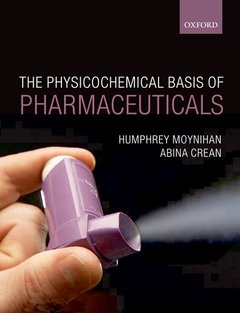Physicochemical Basis of Pharmaceuticals
Langue : Anglais
Auteurs : Moynihan Humphrey, Crean Abina

What are the physical and chemical properties that determine how a drug interacts with the body? What determines which dosage form is best, if it will reach its intended target, and how it will be metabolised once it has entered the body? The Physicochemical Basis of Pharmaceuticals explores the phenomena which affect the formulation and bio-availability of drug substances to give a straightforward, accessible treatment of the essential concepts affecting the absorption and distribution of drugs. It provides the reader with the conceptual 'tool-kit' necessary to understand the physicochemical aspects of drug design and action, and shows how these concepts apply in practice. The book introduces key underlying physical chemistry principles before exploring pharmaceutical solutions, the pharmaceutical solid phase, solid - liquid dispersal systems, biological interfaces, absorption, distribution, metabolism and excretion, to give a complete view of the field. Focusing at all times on the essential principles and concepts, The Physicochemical Basis of Pharmaceuticals avoids excessive detail, presenting the key facts, backed up with pertinent examples and easy-to-digest illustrations, making it the ideal primer for those who need to understand physicochemical issues in the context of their broader field of study. Online Resource Centre For registered adopters of the text: · Figures from the book in electronic format, ready to download For students: · A hyperlinked bibliography of references given in the text.
1. Pharmaceuticals and medicines. 1.1. Introduction to the essential properties of pharmaceuticals. 1.1.1. Some key concepts. 1.2. Classes of pharmaceutical compounds. 1.2.1. Active pharmaceutical ingredients. 1.2.2. Excipients. 1.3. Drug delivery: getting the active pharmaceutical ingredient to the site of action. 1.3.1. Routes of administration. 1.3.2. Pharmaceutical dosage forms. 1.3.3. Factors influencing dosage form choice. 1.4. Summary. 2. Pharmaceutical solutions. 2.2. Definitions and expressions of solubility. 2.1.1. Measurement of solubility and solubility curves. 2.2. Solvent structure. 2.2.1. Hydrogen bonding and the structure of water. 2.2.2. Lipid-based media. 2.3. Dissolution and solvation. 2.4. Factors affecting solubility. 2.4.1. Molecular weight. 2.4.2. Hydrogen bonding. 2.4.3. Hydrophobic and hydrophilic groups. 2.5. Acidity and basicity. 2.5.1. pKa and pKb. 2.5.2. Acidity and environment. 2.6. Salt selection and formation. 2.7. Hydrolytic degradation. 2.8. Summary. 3. Pharmaceutical equilibria. 3.1. Essential concepts in thermodynamics. 3.1.1. Internal energy, enthalpy and the first law of thermodynamics. 3.1.2. Entropy and the second and third laws of thermodynamics. 3.1.3. Free energy, chemical potential and equilibrium. 3.1.4. Activities of ions in solution. 3.2. Phase equilibria. 3.2.1. One-component systems and the phase rule. 3.2.2. Two-component systems. 3.2.3. Osmotic pressure. 3.3. Drug delivery: Phase transitions. 3.3.1. Diffusion (movement within a phase). 3.3.2. Dissolution (solid -liquid transition). 3.3.3. Partitioning (liquid- liquid transition). 3.3.4. Gas absorption (Gas-liquid phase transition). 3.3.5. Phase transitions during drug delivery. 3.4. Summary. 4. The pharmaceutical solid phase. 4.1. Crystalline and amorphous solids. 4.2. The essentials of pharmaceutical crystal structure. 4.2.1. Unit cells, crystal systems and lattices. 4.2.2. Space groups and space group notation. 4.2.3. Crystal planes and faces. 4.3. Crystal polymorphism of pharmaceuticals. 4.3.1. Relative stabilities of polymorphs. 4.3.2. Solvates and hydrates. 4.4. Methods of characterising pharmaceutical solids. 4.4.1. X-ray diffraction methods. 4.4.2. Thermal methods. 4.4.3. Other methods of analysis. 4.5. Pharmaceutical crystallization. 4.5.1. Supersaturation. 4.5.2. Nucleation, growth and crystal morphology. 4.5.3. Ripening and the rule of stages. 4.6. Solid state properties of powder particles. 4.6.1. Particle shape. 4.6.2. Particle size. 4.6.3. Particle surface properties. 4.6.4. Gas adsorption. 4.6.5. Moisture adsorption. 4.6.6. Powder mechanical strength. 5. Two phase solid - liquid disperse systems. 5.1. Introduction to pharmaceutical disperse systems. 5.2. Molecular, colloidal and coarse dispersions. 5.3. The physical stability of disperse systems. 5.4. Properties of disperse systems. 5.4.1. Kinetic properties. 5.4.2. Rheology and viscosity. 5.4.3. Electrical properties. 5.4.4. Interfacial properties. 5.4.5. Optical properties. 5.5. Suspensions. 5.5.1. Nanosuspensions. 5.5.2. Coarse suspensions. 5.6. Emulsions. 5.6.1. Macroemulsions. 5.6.2. Multiple emulsions. 5.6.3. Microemulsions. 5.7. Vesicular systems. 5.7.1. Micellar systems. 5.7.2. Solubilised systems. 5.7.3. Liposomes. 5.8. Aerosols. 5.9. Foams. 5.10. Summary. 6. Biological interfaces. 6.1. Passive, active and other modes of transport. 6.2. Cell membranes. 6.3. Partition and partition co-efficients. 6.4. Measurement and calculation of partition co-efficients. 6.5. Diffusion, diffusion co-efficients and ionisation. 6.6. The gastrointestinal barrier. 6.7. The blood-brain barrier. 6.8. The skin. 6.9. Summary.
Having originally received his BSc and PhD degrees from University College Cork, Humphrey Moynihan returned in 2002, where he is now involved in the teaching of Organic and Pharmaceutical/Medicinal Chemistry. His research interest is the study and control of crystallisation of organic compounds. He is also involved in collaborative research in areas such as Analytical Chemistry. Abina Crean joined the Cork School of Pharmacy in September 2004 as a Lecturer in Pharmaceutics after working in formulation and process development for Élan Pharmaceutical Technologies and Servier (Ireland) Industries. Her main research interests are in the areas of solid dose drug delivery systems and pharmaceutical solid-state properties.
Date de parution : 07-2009
Ouvrage de 320 p.
18.9x24.5 cm
Thème de Physicochemical Basis of Pharmaceuticals :
© 2024 LAVOISIER S.A.S.
